
Whether setting up a new home gym or giving a facelift to your local fitness haunt, your chosen foundation is crucial. It’s not just about going for what looks good – it’s about what feels good and serves your purpose. Will it be rubber’s shock-absorbing resilience, vinyl’s sleekness, or interlocking tiles‘ versatility?
In this little chat, we’re about to have, we’ll explore the A to Z of gym flooring so you can make a choice that supports every rep, every run, and every record-breaking personal best. So, grab your gym bottle, and let’s dive deeply into the world of gym floors. Trust me, it’s more exciting than it sounds and the foundation of every great workout.
Understanding the Basics of Gym Flooring
The floor beneath your feet is where it all begins when setting up a workout space, whether a cozy corner in your home or a full-blown commercial gym. It’s not just about aesthetics; the right flooring can be your ally, supporting every jump and cushioning every drop. So, let’s break down the nitty-gritty of gym flooring, shall we?
What Are the Main Types of Gym Flooring?
First off, gym floors are not a one-size-fits-all deal. There’s a variety to choose from, each with its perks. Here’s the lowdown:
– Rubber Flooring: The MVP of gym flooring, rubber is durable, resilient, and comes in tiles, rolls, or mats. It’s like the trusty friend who’s got your back, no matter how heavy you lift.
– Foam Tiles: These are the softies of the gym floor world. Foam is excellent for low-impact workouts and yoga sessions. Plus, they’re like puzzle pieces – super easy to fit together.
– Vinyl Flooring: Slick and stylish, vinyl is easy to clean and works well in areas where you’re not dropping heavy weights. It’s the neat freak of gym floors.
– Carpet Tiles: Yes, carpet! But not the kind in your living room. These are tough, built to handle the grind, and give a bit of a cozy vibe.
– Wood Flooring: Classic and classy, wood floors are often used in basketball courts and aerobic rooms. They’ve got a bit of bounce and a whole lot of elegance.
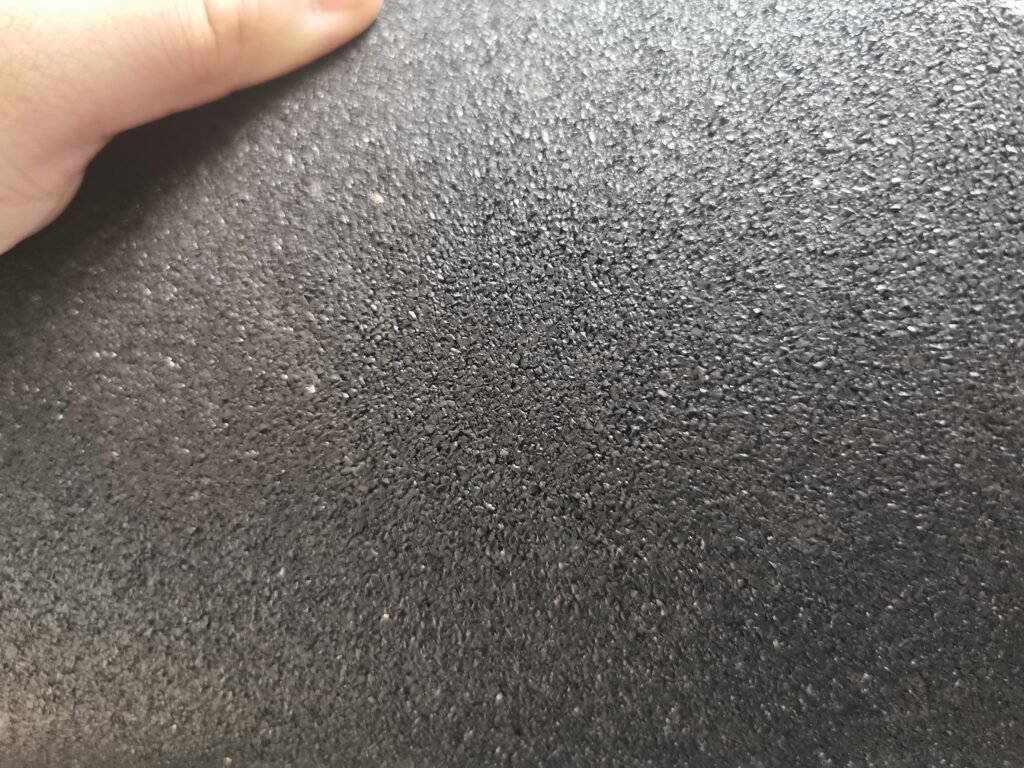
What Types of Floors Are Used in Professional Gyms?
Professional gyms need floors that can take a beating and return for more.
They typically go for:
– High-Density Rubber Flooring: It’s all about withstanding the heavy traffic, drops, and constant pounding. This stuff is thick, challenging, and often made from recycled materials. Eco-friendly and muscle-friendly!
– Interlocking Rubber Tiles: These are the Lego blocks for the serious lifter. They lock in place to create a seamless surface that can handle the heaviest deadlifts.
– Poured Urethane Floors: You’ll see these in high-end facilities. They’re durable and non-porous, and they have this consistent, smooth surface that’s just a joy to maintain.
Each type of flooring has its superpower, whether it’s shock absorption, noise reduction, or just looking darn good. Professional gyms mix and match these options to create the perfect workout environment. So, when choosing your gym’s floor, think about your workouts, equipment, and, of course, your budget. It’s all about finding that sweet spot between functionality and durability.

What is the Best Thickness for a Gym Floor Mat?
The best thickness for a gym floor mat depends on your workout routine. If you’re into yoga or Pilates, a too-thick rug might throw off your balance. Aim for something in the neighborhood of 1/4 inch to 1/2 inch – thick enough to cushion but not so thick that you can’t feel the floor beneath you.
We’re talking a different ball game for those who like to lift weights or do high-impact aerobics. You’ll want something that can absorb shock and protect your floor from heavy equipment. In this case, at least 3/8 inch to 3/4 inch thick mats are your go-to. They’re like the trusty sidekick to your superhero moves – there to save the day when you drop a dumbbell or two.
How Thick Should Weight Lifting Mats Be?
If you’re serious about your weightlifting, you’ll need a mat that’s up to the task. We’re looking at mats that are at least 3/4 inch thick. These mats are the bodyguards for your floor – tough and ready to handle the heavy stuff. They’re designed to absorb the shock of dropped weights, which means they help protect both your equipment and the floor, and let’s not forget, they also silence that booming sound of a barbell meeting the ground.
But here’s a pro tip: if you’re into Olympic weightlifting or deadlifts are your jam, consider going even thicker. Up to 1-inch thick Mats provide that extra buffer that can handle the weight and intensity of your lifts. Plus, they tend to be denser, which means they’re less likely to curl or buckle under pressure – because the last thing you want mid-lift is a mat that’s more wobbly than your legs after a squat session.
Ultimately, the thickness of your gym mat should match the intensity of your workouts. It’s about finding that spot where durability meets comfort and your floor stays as unscathed as your post-workout high. So, take a moment to consider your routine, and choose a mat that’ll go the distance with you.
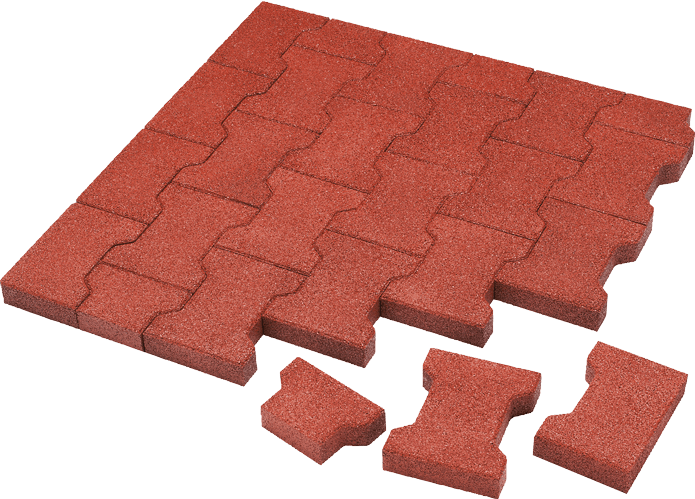
Fine-Tuning Your Weight Room with the Right Flooring
Weightlifting isn’t just a sport; it’s a commitment to strength, and your gym’s flooring should echo that commitment. Let’s delve into the essentials of outfitting your space with the kind of deadlift mats that are up to the task – whether for a bustling commercial gym or a dedicated weight room in your home.
Is It Crucial to Use Deadlift Mats?
Indeed, it is! Deadlift mats are the unsung heroes in the weight room. They’re not just another item on your wishlist but a must-have. These heavy-duty mats are designed to take a beating from barbells and dumbbells, safeguarding your floors from the wrath of iron plates. And let’s not forget; that they also help to minimize that thunderous crash that can startle the entire gym (or your household).
But it’s not just about the protection of property; it’s about the safety and performance of the lifter. A quality deadlift mat provides a stable and secure top side that helps to prevent slips, especially when things get a little wet from intense workouts. The upgrade makes you want to hit ‘add to cart’ and ‘check out’ without a second thought.
Optimal Thickness and Material for Deadlift Mats
Regarding deadlift mats, thickness, and material are not to be skimped on. We’re talking at least 3/4 inch of high-density, heavy-duty rubber that’s been battle-tested in the toughest of commercial gyms across the USA. This kind of mat doesn’t just absorb shock; it distributes it, keeping both your floor and your weights pristine.
The ideal deadlift mat is like a trusty car mat – it’s there to protect and serve, no matter what rolls in on your tires (or, in this case, your barbells). And with mats made in the USA, you often look at the superior quality that can withstand the quantity and intensity of a bustling gym environment. These mats interlock seamlessly, too, so you can cover as much ground as you need without worrying about gaps or uneven surfaces.
When selecting your mats, consider the width and length that will accommodate your space and the quantity of weights you’ll be hoisting. You want enough coverage to ensure every drop and every deadlift is performed confidently. And with features that include easy installation and low odor – a familiar and unwanted guest in many weight rooms – you’ll be more than happy with your purchase.
So, whether doubling down on your home gym setup or stocking up for a commercial space, adding deadlift mats to your cart is smart. They’re the kind of product that brings a sense of completeness to your gym, reduces noise, and reduces wear and tear. Plus, they come in colors and styles matching the aesthetic you’ve always wanted.

Deciphering the Best Material Choices for Gym Flooring
Selecting the ideal gym flooring mat is akin to choosing the perfect pair of running shoes—it’s a crucial decision that can significantly impact your workout experience. Let’s delve into the materials that will lay the groundwork for your fitness pursuits.
Rubber Mats vs. Foam Mats: Which Reigns Supreme for Gym Flooring?
Regarding gym flooring, rubber mats are the stalwarts, known for their durability and resilience. They’re the go-to for garage gyms where heavy weights and rigorous routines demand a surface that can take a beating without flinching. Rubber mats protect your base from the relentless drop of consequences and the constant shuffle of feet, all while reducing the rubber smell that can sometimes be a byproduct of lower-quality materials.
With their shock-absorbing properties, foam mats are the unsung heroes of low-impact workouts and areas where comfort is king. They’re helpful companions for activities like yoga or Pilates, providing a supportive cushion for your body’s connection with the ground.
When deciding between the two, consider the nature of your workouts. Rubber is your ally for heavy-duty activity, while foam is your friend for floor-based exercises. And if your gym sees various activities, why not double up? Use rubber where the heavyweights live and foam where you’ll be hitting the mat for some crunches.
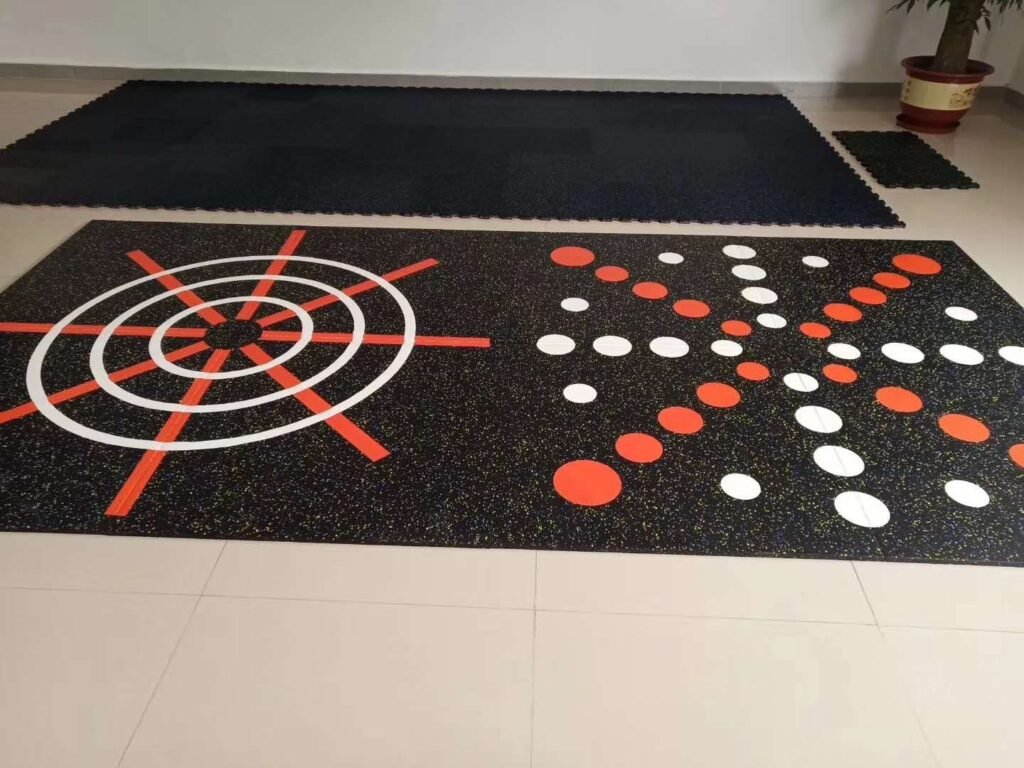
Laying the Foundation: What Goes Beneath Rubber Gym Flooring?
Installing rubber tiles is straightforward; they’re designed to lay snugly on a flat, clean surface. However, if you’re looking to cut down on the rubber smell or add a layer of protection against potential damage, consider what lies beneath.
For those adding gym flooring mats to their wishlist, note that an underlay might not be necessary, but it can be helpful. It can reduce noise, especially in a home or garage gym, and provide a buffer that protects the tiles and your subfloor.
If you’re about to add rubber mats to your cart, remember that they can be installed directly over your existing floor. Still, a moisture barrier or acoustic underlay might be a wise choice if you’re in a damp location or need to minimize noise.
Before you finalize your order, please review the color options and cut of the mats to ensure they fit your space’s aesthetic and dimensions. High-quality rubber mats are an investment in your gym’s longevity—they’re built to withstand the rigors of a challenging workout and protect your space from wear and tear.
In summary, rubber gym flooring mats are a solid choice whether you’re outfitting a commercial site or a home setup. They ship directly to you, ready to be installed, and offer a robust solution that matches the rigors of a serious workout regimen.
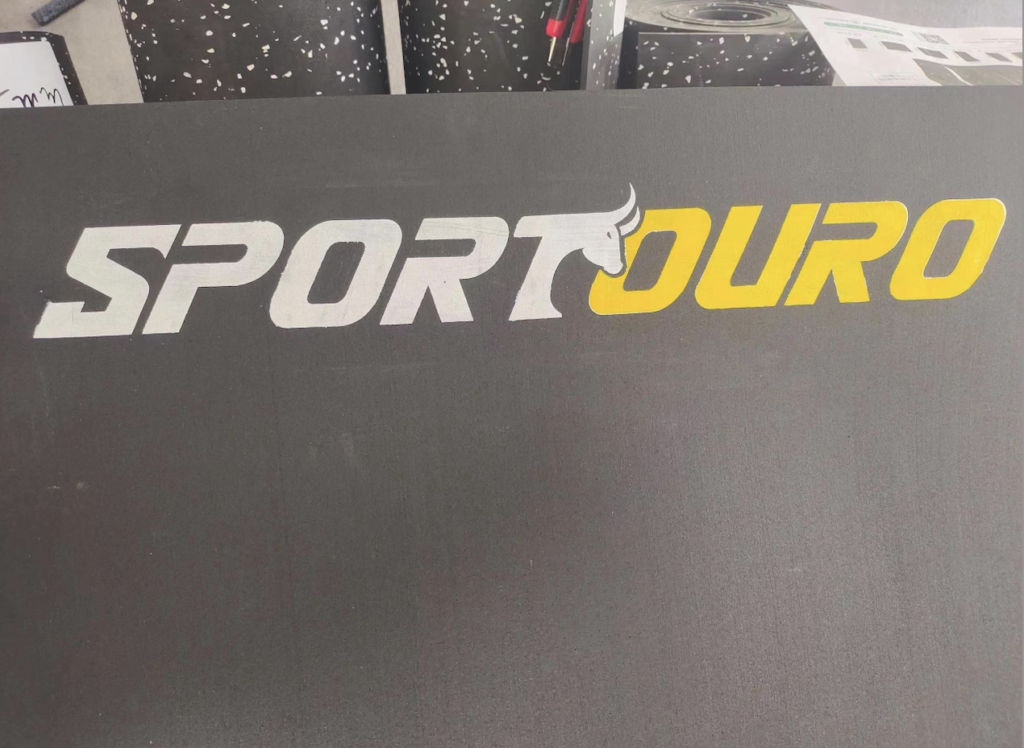
Addressing Installation Questions
The installation process can feel like a workout when setting up your gym! But don’t sweat it; we’re here to tackle some of the most common head-scratchers about laying down those gym mats and rubber flooring.
Do I Need a Gym Mat on Concrete?
If your workout space has a concrete floor, you might wonder if you can get by without a gym mat. Here’s the straight talk: Concrete is brutal. Like, hard. While it might seem tough enough to handle anything you throw at it, that’s only half the story. A gym mat does more than protect the floor; it protects you.
The cushioning of a good mat can save your joints from the unforgiving nature of concrete, absorb the shock of heavy weights, and even keep your equipment from getting damaged. Plus, it’s a surefire way to prevent your gym from sounding like a construction site whenever you lose weight. So, in short, treat your concrete floor to a gym mat. Your body (and your neighbors) will thank you.

Can You Install Rubber Flooring Over Underfloor Heating?
Rubber flooring and underfloor heating might seem odd, but they can get along quite well. The key is ensuring the heating system is compatible with rubber flooring. Rubber is a natural insulator that can prevent some of the heat from your underfloor system from escaping into the room.
However, it’s okay. Many rubber flooring options are designed to work with underfloor heating, allowing the warmth to permeate through gently. Just be sure to check the specifications of both your heating system and the rubber flooring to ensure they’re a good match. And remember, always consult with a professional before installing to avoid mishaps or warranty woes.
Safety and Maintenance of Gym Flooring
Ensuring your gym flooring is safe and well-maintained is as crucial as the workout. After all, the foundation of a good fitness routine is the floor you stand on. Let’s delve into keeping that foundation solid, starting with the slip factor of rubber tiles.
Are Rubber Tiles Slippery When Wet?
Rubber tiles are a popular choice for gym flooring due to their durability and shock absorption. But what happens when sweat drips or water spills? Generally, high-quality rubber tiles are designed with a non-slip surface, even when wet. They typically have a textured top layer that helps to provide traction. However, like any surface, they can become slippery if there’s an excess amount of liquid. It’s always best to keep your gym flooring as dry as possible.
If you’re running a commercial gym or have a busy home gym, consider placing absorbent mats in high-traffic or sweat-prone areas, and always have towels handy for quick wipe-downs.
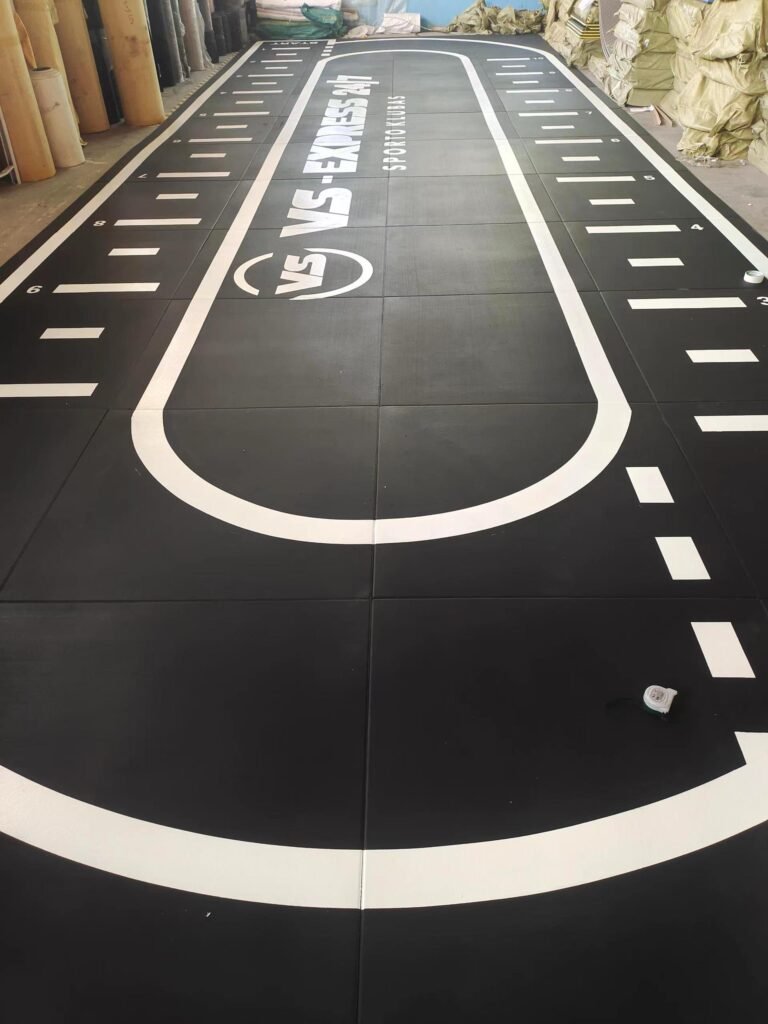
How to Clean and Maintain Rubber Gym Flooring?
Rubber gym flooring is relatively low-maintenance, but regular cleaning will extend its life and keep it looking fresh.
Here’s a simple routine to keep your rubber floors in top shape:
1. Daily Dusting: Use a microfiber dust mop or a vacuum cleaner designed for hard surfaces to remove dust and debris. This prevents the buildup of grime and keeps the surface safe for workouts.
2. Weekly Washing: Mix a mild soap with water and use a mop to clean the tiles. Avoid using harsh chemicals, as they can break down the rubber and cause it to wear out faster.
3. Spot Cleaning: Immediately clean spills or stains with a cloth or sponge to prevent them from setting in. For stubborn stains, use a cleaning solution recommended by the flooring manufacturer.
4. Deep Cleaning: Every few months, you may want to do a more thorough cleaning. You can use a machine like an auto-scrubber with a soft brush attachment to deep clean the surface without damaging it.
5. Maintenance Checks: Regularly inspect for any damage or wear and tear. If a tile is damaged, the great thing about rubber tiles is that you can simply replace the affected piece without having to redo the entire floor.
Remember, the key to maintaining rubber gym flooring is consistency. A little bit of regular attention goes a long way in keeping your gym’s foundation safe and sound for everyone’s daily grind.
Understanding Fire Safety Standards for Gym Flooring
When decking out our gym spaces, we’re often so focused on the physical benefits and aesthetics that we overlook one crucial aspect: fire safety. But just like a good spotter, fire safety standards are there to protect us. Let’s deepen our understanding of the fire classifications for gym floor coverings, focusing on the safety credentials of rubber gym flooring.
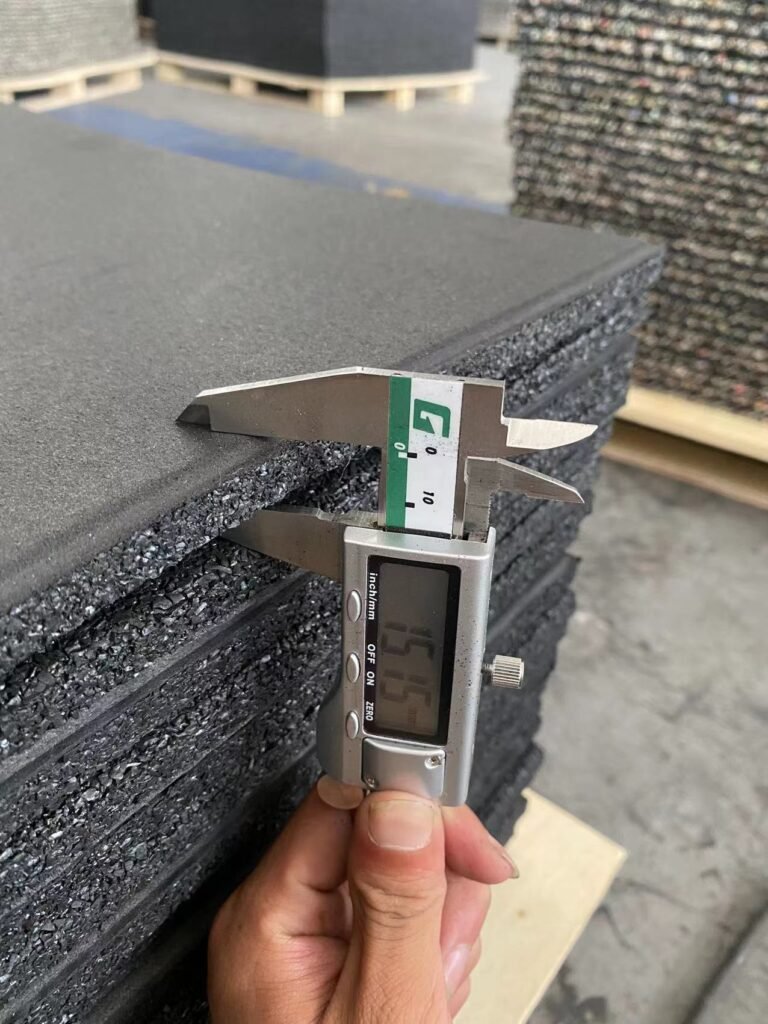
What Fire Classification Is Gym Floor Covering?
Fire classification for gym floor coverings is a critical safety measure, categorized by the material’s reaction to fire, including how quickly it can ignite, how much it contributes to the spread of fire, and how much smoke it produces.
In the United States, commercial gym flooring typically needs to meet the National Fire Protection Association (NFPA) standards. The NFPA classifies materials from Class A to Class C, with Class A being the most fire-resistant. This classification is based on the flame spread index and smoke-developed index tested in accordance with ASTM E84, commonly known as the Steiner Tunnel Test.
Rubber gym flooring is famous to many fitness enthusiasts for its durability and shock absorption. It is designed to be fire-resistant and usually falls into Class B or Class C regarding fire classification.
– Class B materials have a flame spread index of 26 75 and are considered suitable for most commercial environments, including schools, offices, and gyms. They are designed to slow the spread of flames and produce a moderate amount of smoke, making them a safer choice for areas where people gather in larger numbers.
– Class C materials have a flame spread index of 76-200 and are often used in areas with lower risk of fire. They offer protection but are less resistant to fire spread than Class A or B materials.
We’re proud to announce that our rubber gym flooring has passed rigorous fire standard testing, ensuring that it meets the stringent requirements for fire safety. This means our flooring provides the durability and performance you expect from a top-tier gym surface and adheres to the highest safety regulations. When you choose our rubber gym flooring, you’re not just investing in a product that will stand up to the most strenuous workouts; you’re also choosing peace of mind, knowing that it’s designed with your safety in mind.
It’s important to remember that specific fire safety requirements vary by local jurisdictions, so it’s essential to check with local building codes and fire safety standards when selecting gym flooring. Additionally, we can provide a fire rating certificate for our products upon request.
When planning your gym, always prioritize materials that support your fitness goals and adhere to fire safety regulations. It’s not just about compliance; it’s about ensuring the well-being of everyone who steps foot in your fitness haven. Safety is as important as the workout itself, and with our fire-tested rubber gym flooring, you get the best of both worlds.

Cost and Value Considerations
Budgeting for flooring is a balancing act when outfitting a gym, whether a compact home setup or a full-scale commercial operation. You want the best value for your money without compromising on quality. Let’s explore the financial side of gym flooring, uncover some cost-effective solutions, and understand the pricing behind popular choices like rubber tiles.
What is the Cheapest Way to Floor a Gym?
If your budget is tight, but you’re eager to get your gym up and running, you might be looking for the most economical flooring solution. The cheapest way to floor a gym is often to opt for EVA foam tiles. They’re lightweight, easy to install, and provide decent cushioning for activities that don’t involve heavy weights or machinery. Another cost-saving option is to seek out recycled rubber mats or second-hand commercial flooring that can offer durability at a fraction of the cost.
However, it’s important to note that while upfront costs are lower, these options may not provide the long-term durability and protection that more expensive flooring solutions offer. It’s a trade-off between immediate savings and potential future costs for repairs or replacements.
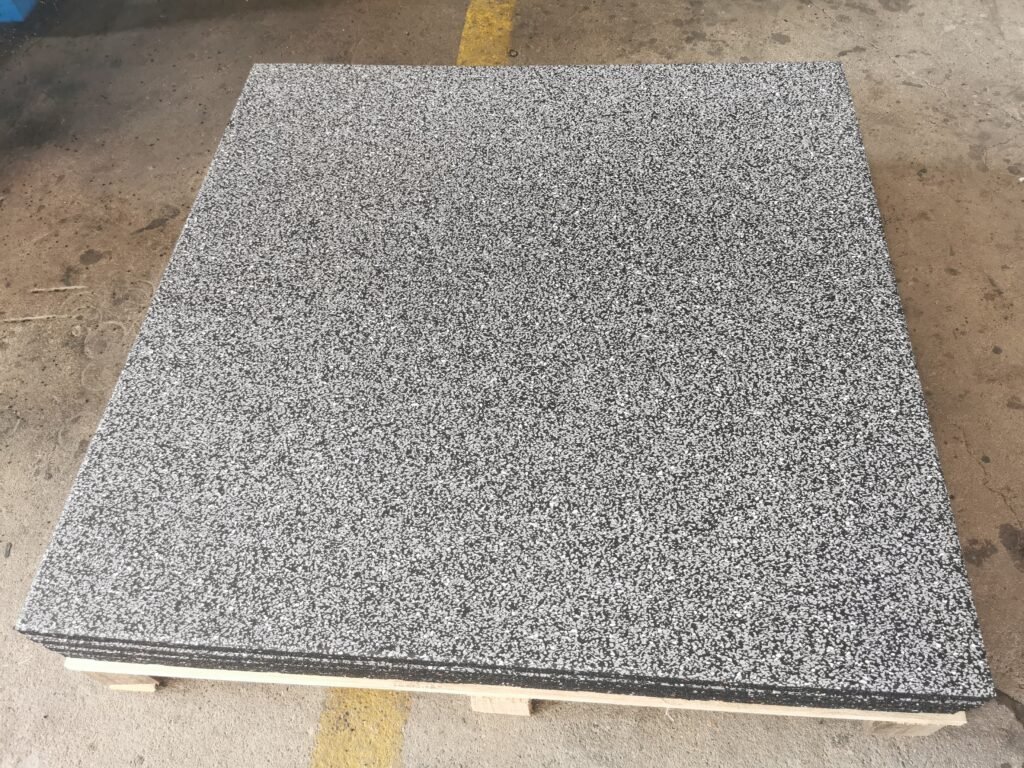
Why Are Rubber Tiles So Expensive?
Rubber tiles are a premium gym flooring option, and their price tag reflects their status. There are several reasons why rubber tiles come with a higher cost. Firstly, the material is inherently durable and resilient, capable of withstanding heavy impact and high traffic without significant wear and tear. This means they offer a longer lifespan than many other flooring options.
Additionally, the manufacturing process of high-density rubber tiles is more complex, often involving significant quality control to ensure they meet safety and performance standards, such as fire resistance and low toxicity. Rubber tiles often come with professional-grade features like interlocking edges, water resistance, and sound-dampening properties, all of which add to the cost.
Lastly, rubber tiles are an investment in the safety and comfort of gym users. They provide excellent traction, reducing the risk of slips and falls, and their shock-absorbing qualities help protect joints during high-impact activities.
In essence, when you purchase rubber tiles, you’re not just buying a product but investing in a long-term flooring solution that offers safety, durability, and a professional-grade workout environment. While the initial outlay may be higher, their long-term value can make them a more cost-effective choice over time.
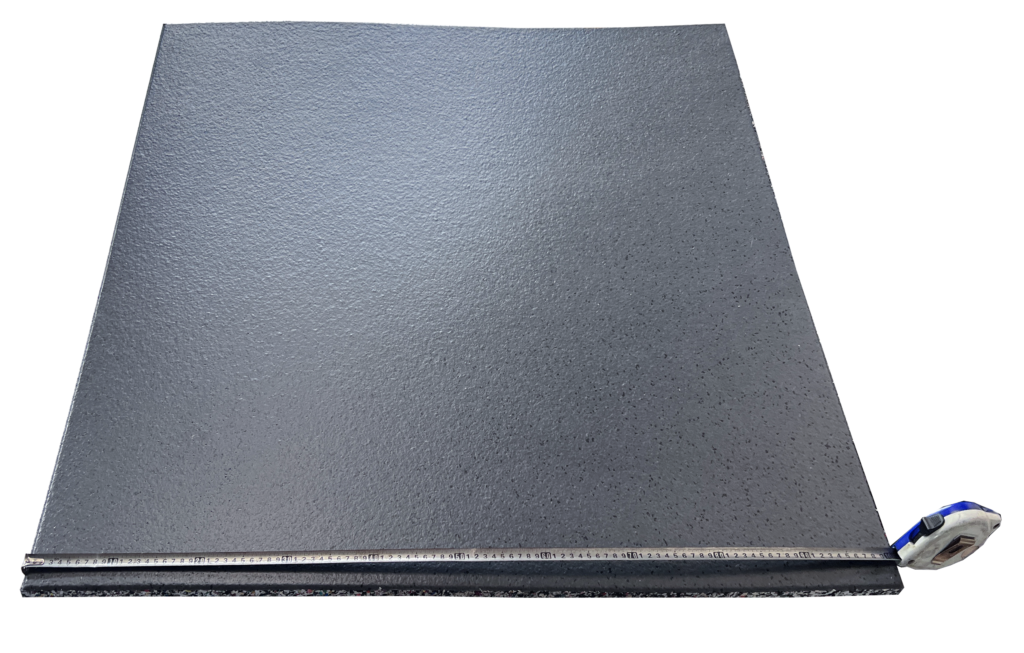
Rubber gym flooring is a popular choice in the fitness world due to its durability, safety, and ease of maintenance. While the initial investment and installation process may be prohibitive for some, its long-term benefits, such as shock absorption and noise reduction capabilities, often justify the upfront cost.
Although rubber flooring has some drawbacks, such as the potential for odors, its benefits are compelling. It is a resilient, reliable surface that supports the health and safety of gym-goers and proves its worth over time. Whether building a new gym or upgrading an existing one, rubber flooring is a solid, long-term solution worth considering.


